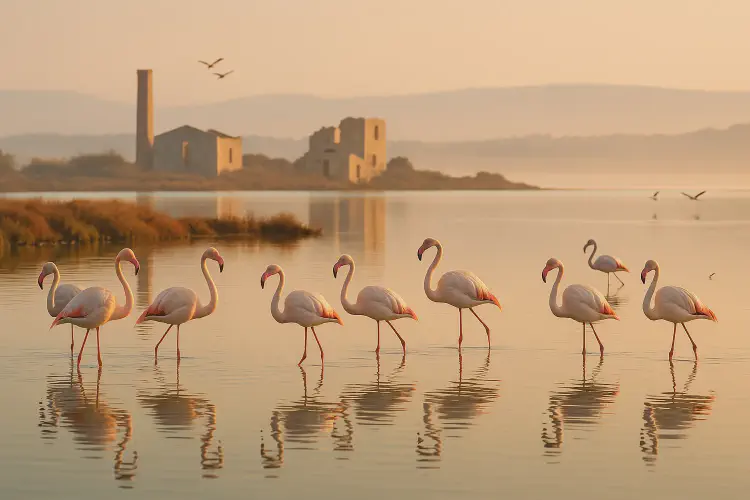Wildlife-friendly tourism in Sicily
Sicily is home to an incredible range of wildlife — from flamingos and sea turtles to dolphins, bees, and mountain foxes. Choosing wildlife-friendly tourism ensures that your encounters with nature are respectful, educational, and supportive of conservation rather than exploitation.
- Visit Sicily
- 3 min read

Wildlife-Friendly Tourism in Sicily — Explore Nature with Respect
🌿 Overview
Sicily’s diverse landscapes — volcanic slopes, wetlands, forests, and marine reserves — provide habitats for countless species. Travelers can enjoy this biodiversity by choosing responsible experiences that protect wildlife and fund conservation. Whether birdwatching in Vendicari or spotting dolphins off the Aeolian Islands, mindful tourism helps ensure these treasures endure.
🐦 1. Birdwatching and Nature Reserves
Sicily lies on a major migratory route between Europe and Africa, making it a paradise for birdwatchers.
Top locations:
- Vendicari Nature Reserve (Noto): home to flamingos, storks, herons, and ospreys.
- Saline di Trapani e Paceco Reserve: salt flats attracting avocets, spoonbills, and other waterbirds.
- Biviere di Gela Reserve: Sicily’s largest coastal wetland, crucial for migration and breeding.
How to visit responsibly:
- Bring binoculars instead of drones.
- Stay on marked trails and avoid loud noises.
- Visit observation huts rather than approaching birds directly.
🐢 2. Support Sea Turtle Conservation
Several Sicilian beaches host nesting loggerhead turtles (Caretta caretta) — an endangered species.
Key initiatives:
- Lampedusa Turtle Rescue Center (Centro Recupero Tartarughe Marine): rehabilitates injured turtles and educates visitors.
- WWF Sicilia Nord-Orientale and Legambiente run summer programs to monitor nests and guide beachgoers.
How to help:
- Never disturb nesting turtles or hatchlings.
- Avoid beach lights at night and remove umbrellas or chairs after use.
- Join volunteer programs during nesting season (June–September).
🐬 3. Choose Responsible Marine Tours
The waters around Sicily — especially the Aeolian Islands and Ustica — are perfect for seeing dolphins and whales.
Responsible options:
- Book with certified eco-operators following Code of Conduct for Cetacean Watching.
- Keep a respectful distance (100+ meters) and avoid feeding or touching wildlife.
- Avoid tours that chase animals or play loud music.
Species you might see: bottlenose dolphins, fin whales, sperm whales, and pilot whales.
🦊 4. Explore National Parks and Mountain Wildlife
Sicily’s mountains offer a refuge for unique animals and plants.
Highlights:
- Madonie Mountains: home to wildcats, foxes, and over 1,500 plant species, including rare Sicilian fir trees.
- Nebrodi Park: Sicily’s largest forest, with wild boars, hedgehogs, porcupines, and numerous birds of prey.
- Etna Park: volcanic habitats shelter kestrels, lizards, and the endemic Etna violet.
Eco-tips:
- Use local certified hiking guides.
- Avoid off-trail hiking to protect fragile flora.
- Never feed wild animals or collect plants.
🐝 5. Support Pollinators and Local Biodiversity
- Visit organic farms producing honey, almonds, and citrus using bee-friendly methods.
- Buy local honey instead of imported brands — it supports pollinator conservation.
- Some agriturismi in Noto and Ragusa offer beekeeping workshops for visitors.
Why it matters: Bees are vital for Sicily’s agriculture and ecosystem health.
🐠 6. Snorkeling and Diving with Care
- Sicily’s marine life is fragile — from Posidonia seagrass to coral reefs.
- Choose dive centers certified by PADI Green Star or WWF Travel Nature.
- Avoid touching corals or collecting shells.
- Use reef-safe sunscreen and biodegradable gear cleaners.
Top spots: Ustica Marine Reserve, Zingaro coast, and the Aeolian Islands.
🌍 7. Participate in Citizen Science or Eco-Volunteering
- Join bird monitoring, turtle patrols, or beach clean-ups with local NGOs.
- Share wildlife sightings on citizen science apps like iNaturalist or Observation.org.
- Many Sicilian parks welcome short-term volunteers for trail maintenance and education.
🚫 8. Avoid Animal Exploitation Activities
- Never support attractions using captive animals (circuses, private zoos, exotic photo ops).
- Don’t ride donkeys or horses unless the animals are visibly healthy and treated well.
- Skip markets selling wild-caught pets or coral souvenirs.
🧭 Summary
Wildlife-friendly tourism in Sicily allows travelers to experience the island’s natural wonders while protecting them. By observing respectfully, supporting conservation programs, and choosing responsible operators, you help ensure that Sicily’s flamingos, dolphins, turtles, and forests continue to thrive. Traveling with awareness turns every encounter with nature into an act of preservation.